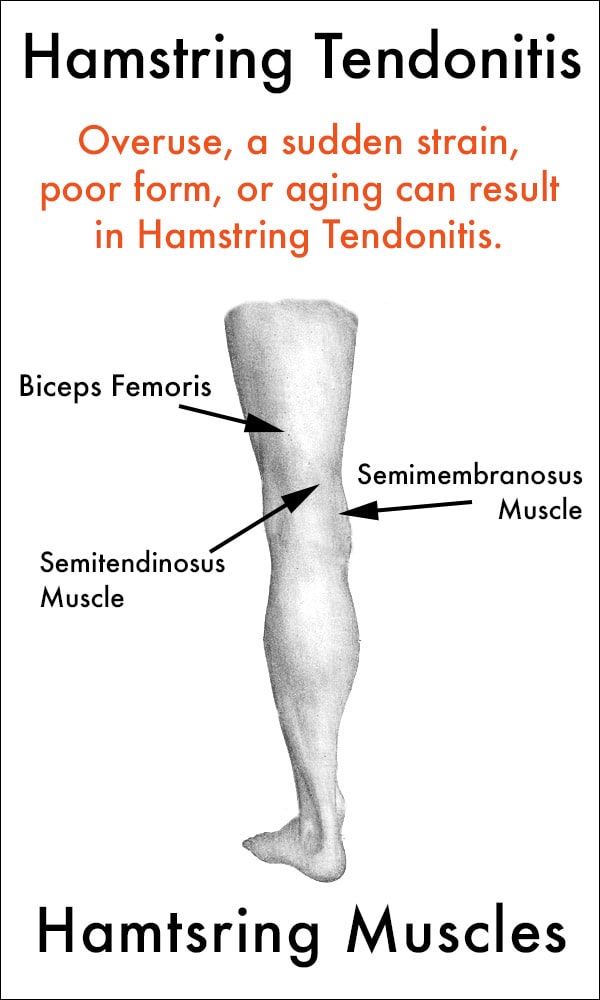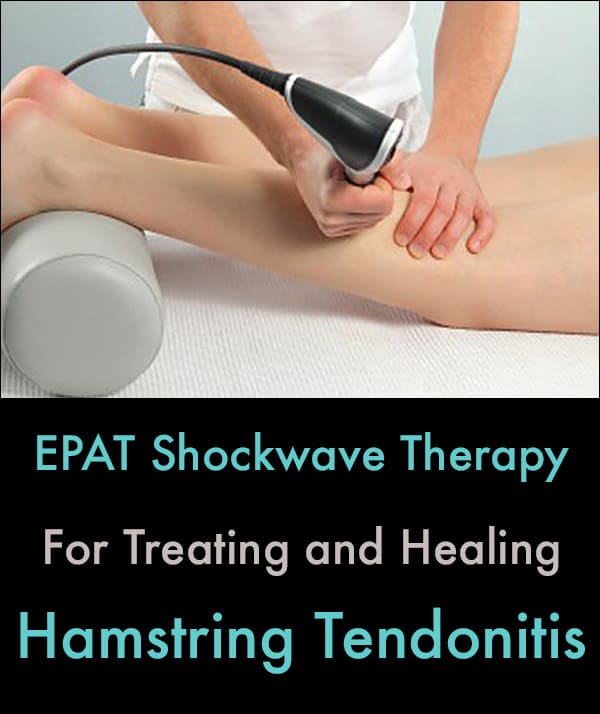Soft tissue injuries are always uncomfortable and inconvenient, and Hamstring Tendonitis is no different.
This condition tends to sideline both professional and amateur athletes, as well as anyone who stays in shape by running or doing other types of moderate to high-impact workouts.
People whose jobs require a lot of physical activity, such as firefighters, police officers, EMTs or construction workers are also at risk for this or other types of soft tissue injuries.
Do You Have Pain Behind the Knee?
The soft tissue that connects the hamstring muscle to the pelvis, shinbones and outer part of the knee is known as the hamstring tendon or tendons. If that tendon gets inflamed, torn, or is otherwise strained, a person might first notice pain in the back of the knee and, sometimes presenting in the thigh as well.
Left untreated, the pain caused by this type of injury generally continues to increase over time, especially if a person is unable or unwilling to stop or alter the movements that lead to the tendonitis in the first place.
Hamstring tendonitis is often diagnosed with an X-ray or an MRI scan.
Three hamstring muscles are located behind the knee at the back of the thigh:
- Biceps Femoris
- Semimembranosus Muscle
- Semitendinosus Muscle
These muscles work together to flex the knee and extend the hip. Many times the semitendinosus muscle is overused or strained resulting in what is commonly known as a pulled hamstring. This muscle is located between the semimembranosus muscle and the biceps femoris.
What are the Causes of Hamstring Tendon Injuries?
There are a variety of reasons people experience a pulled muscle behind the knee and many times it is related to the hamstring tendons.
Common causes of hamstring tendonitis injuries include:
- Overuse or repetition
- Strain from not warming up before activity
- Quick change in speed or movement
- Poor form
- Overtraining with heavy weights
- Returning to sports or activity too soon
- Aging
The main reason an individual develops hamstring tendonitis is due to overuse. This means that they are performing a repetitive movement that continually stresses the tendons behind the knee, along with the muscles behind the knee.
This condition is common among athletes who compete in sports that require running and jumping. Amateur athletes and even hobbyists are at risk as well.
While overuse is the most common culprit, a sudden strain on the hamstring tendon can lead to injury, most often if an individual has not warmed up or stretched an appropriate amount before taxing this area of the body.
Sudden hamstring tendon pain can be the result of a quick change in speed, which is required in all kinds of sports like baseball, football, track and field and many, many others.
Poor form when exercising, overtraining or working out with weights that are too heavy can also lead to this condition.
Others who might be returning to intense exercise after a period of little to no activity are susceptible as well, if they try to push too hard too soon.
Finally, advancing age can play a factor because people lose muscle mass and strength as they get older.

What are the Symptoms of Hamstring Tendonitis?
Hamstring tendon pain symptoms can range from slightly uncomfortable to severe pain depending on the person’s age, athletic ability, and reason for the injury.
The most common symptoms of hamstring tendonitis can include some of the following:
- An increase in the amount of pain, especially as it relates to a repetitive movement
- Pain in the knee joint or the close surrounding areas
- Swelling and tenderness in the area of the knee and thigh
- Radiating pain that travels up the thigh and, sometimes, to the hips and pelvis
- Poor flexibility and pain when the knee is bent
- Intense pain when trying to walk or bend the knee
What is the Treatment for Hamstring Tendonitis?
Recovery from hamstring tendonitis varies from 10 days to 10 weeks, depending on how severe the injury is and what course of treatment an individual takes.
Typical Hamstring Tendonitis Treatments Include:
1. RICE
In minor cases, the RICE Method (Rest, Ice, Compress, Elevate) can be effective in reducing pain and inflammation, especially in the first 72 hours following an injury.
Resting allows the injury time to heal, and ice can reduce pain and inflammation, as well as using a compression bandage and elevating the hamstring above the heart.
2. EPAT Shockwave Therapy
EPAT Therapy (also known as Shockwave or Pressure Wave Therapy) is a non-invasive method for increasing the speed of healing and limiting injury-related downtime.
This regenerative treatment helps injured muscles and tendons heal faster by delivering impulse pressure waves deep within damaged soft tissue. With each session, deep muscle stimulation increases blood flow to the hamstring tendon and reduces inflammation.

The Benefits of EPAT Shockwave Therapy for Treating Hamstring Tendonitis Include:
- Surgery is not required
- No side effects
- Healing is accelerated
- Improved pain reduction
- Earlier return to normal activities or sports
Because EPAT Therapy is non-surgical, there is no anesthesia necessary, no scarring, and no risk of infection. In some cases, athletes can actually undergo treatment sessions while still maintaining high levels of performance.
Hamstring Tendonitis is just one of the many treatable conditions that have shown success from using EPAT Shockwave Treatment.
This video shows a typical EPAT treatment session for a hamstring tear on a runner by Dr. Scott Duke, of Duke Chiropractic.
3. Nonsteroidal Anti-inflammatory Medication
Nonsteroidal anti-inflammatory medications, like ibuprofen or Advil, can also be helpful. As inflammation and pain decreases, light stretches and targeted massage around the hip, knee and thigh may ease tension and loosen the muscles.
4. Taping and Strapping
Taping or strapping the hamstring using a Hamstring Tendonitis brace can reduce stress on the muscles and tendons and keep everything from moving for faster healing.
Returning to Normal Activity After Hamstring Tendonitis
It can’t be stressed enough that returning to normal activities after an injury too soon such as hamstring tendonitis can prolong the healing process and further complicate the injured tissue.
For those who need to return to sports for competition, or others who must work in high-intensity jobs, it’s best to seek treatment from a qualified professional who can provide proper therapy to heal quickly and reduce the downtime.
Many world-class physicians and sports medicine professionals are turning to EPAT Shockwave Therapy as a way to improve and accelerate healing for their patients because of the positive results they have seen in their offices and clinics.